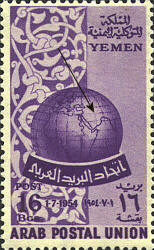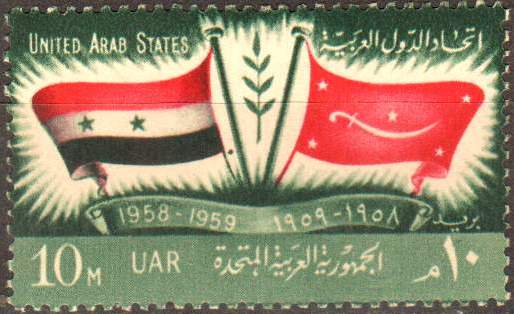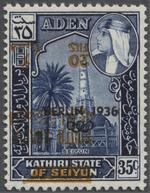How the north-south relationship in Yemen is changing
This piece was contributed by Bilal Ahmed, a student and activist completing his senior year at Rutgers University who has spent time in Yemen. This piece was primarily written during his stay in Tahrir Square, Egypt. As always with guest contributors, their opinions are their own.
There are flags hanging in many buildings in the southern Yemeni city of Aden. These flags, in addition to the standard Yemeni red, white, and black, contain a light blue triangle with a red star within it. They are seen everywhere, from tea shops, to private homes, to the crowds of protestors that have been marching on Aden’s streets for the past year.
These are the flags of the People’s Democratic Republic of Yemen, colloquially known as “South Yemen.” The PDRY was an avowedly Stalinist-Marxist single-party state, though its classification as such is a matter of debate. More significant than Marxism in the history of South Yemen was the state’s mobilization of dormant nationalism among South Yemenis.
“North Yemen” extends from the Saudi Arabian border to the de facto border between North and South signed by the Ottoman and British Empires in 1905. South Yemeni nationalism is rooted in the different histories that birthed the two former states, with North Yemen initially ruled by Imamates and finally an autocratic Yemen Arab Republic (YAR) “President” in Ali Abdullah Saleh.
South Yemen has an entirely different past that must be understood in the wake of its growing geopolitical focus.
The two histories diverge in the 19th century, when British East India Company forces seized control of Aden in 1832 and established it as a coaling station for British ships traveling to and from colonial India. British holdings in South Yemen expanded beyond the city over the following decades, spurred on by a desire to reduce pirate attacks and gain a stronger strategic base for reinforcing the Suez Canal.
 The British, mainly extending their administrative control through local monarchs in an approach similar to that undertaken in the Persian Gulf, finally reorganized South Yemen in 1937 as an independent crown colony.
The British, mainly extending their administrative control through local monarchs in an approach similar to that undertaken in the Persian Gulf, finally reorganized South Yemen in 1937 as an independent crown colony.
South Yemen’s encounter with foreign imperialists is markedly different from that of North Yemen, which was mainly in conflict with its own monarchs after its 1917 independence and Egyptian-Saudi Arabian proxy war.
Although violence in North Yemen had a significant effect on events within South Yemen, an insistence of South Yemeni “modernity” would prevail over the following decades. The attitude began as a minor characteristic that would accentuate significantly during later years. However, the bleeding of serious anti-royalist action into South Yemen points to both nations being united in their hatred of the old ‘Order’ in spite of this. Escalating tensions between royalists and anti-monarchists challenged the narrative of North Yemen as broadly “traditionalist”.
South Yemenis felt emotionally connected to a North issuing many allegedly “Southern” demands, which established links of solidarity among the two colonial states. This phenomenon of prejudices being challenged by revolutionary facts would continue to define the North/South dynamic.
South Yemenis, already mobilizing against British rule due to political strife and economic stagnation, were now seen as a major threat. Fearing another serious revolt against a colonial European power, the British Empire reorganized South Yemen into a series of protectorate states known as the Federation of South Arabia on 4 April 1962. The British scheduled South Yemen’s independence for 1968, hoping that a government of allied royalists would protect its remaining interests in the region.

The plan was marked by ambivalence towards the wishes of South Yemenis, valuing notions of “stability” in the face of the broad existential chaos of “instability.” Instability was defined by parties opposed to colonial interests and allies in the Arabian Peninsula just as terrorism is rhetorically exploited in present day. South Yemenis reacted to the plan with disdain, as many correctly recognized it as an attempt to continue exploitation of the colony through independence.
Their distress was quickly mobilized into organized insurrection, culminating in the 1963 formation of anti-British military factions such as the National Liberation Front (NLF) and the Frontier for the Liberation of Occupied South Yemen. The speed and effectiveness of this organization was highly affected by violence in North Yemen, once again reinforcing ties between the two states. British forces responded by declaring the Aden Emergency, a period of intense violence between South Yemeni paramilitary forces and the British colonial presence with allied support within South Yemen.
The success of these initiatives were pronounced in the early withdrawal of British forces and the People’s Republic of South Yemen’s independence on 30 November 1967. The national consciousness began to revolve around using violent mechanisms to forcibly remove the exploitation of the old Order. This removal was pronounced in an assertion of South Yemeni interests through opposition to the control of sultans, emirs, and other royalist entities.
 Royalists and monarchs were seen as an exploitative influence that needed to be combatted, as they prevented wider political and economic participation by South Yemenis. Marxism became a mechanism for instigating this removal just as Islamism in later decades, though in reality the eventual state was Stalinist. Marxist (Stalinist) wings of the NLF gained control of the country and renamed it the People’s Democratic Republic of Yemen (PDRY) on 1 December 1970.
Royalists and monarchs were seen as an exploitative influence that needed to be combatted, as they prevented wider political and economic participation by South Yemenis. Marxism became a mechanism for instigating this removal just as Islamism in later decades, though in reality the eventual state was Stalinist. Marxist (Stalinist) wings of the NLF gained control of the country and renamed it the People’s Democratic Republic of Yemen (PDRY) on 1 December 1970.
Dormant anti-royalist sentiment became attached to PDRY nationalism, with a strong sense of distinction from the renamed Yemen Arab Republic (YAR) reemerging after the 1978 election of the North Yemeni strongman Saleh. As the PDRY exported a Marxist-inspired ideology of anti-monarchism to the rest of the Arabian Peninsula, cosmopolitan pedagogies became attached to Southern nationalism.
While the PDRY’s status as “Marxist” is a matter of debate, there is certainly a direct line between its revolutionary anti-monarchical stances and the current popularity of federalized democracy in South Yemen. South Yemenis, particularly in Aden, express a strong desire for their interests to be represented in the greater Yemeni state through federalized democratic structures. The influence of leftist democratic ideas during the PDRY’s lifespan certainly contributed to this phenomenon.
Interestingly, these ideologies required South Yemenis to be defined in opposition to an external force. The PDRY began to echo colonial behaviors, as its progressive behaviors needed to be seen in opposition to counterrevolutionary patterns elsewhere. Although Saudi Arabia and the predominantly monarchist GCC often filled this role, the increasingly autocratic YAR began to increasingly dominate this dynamic. The ‘civilized’ South Yemen began to be seen in opposition to the ‘uncivilized’ North Yemen, and slurs such as ‘savages’ entered the South Yemeni lexicon.
 As a result, the YAR and PDRY entered their 1990 unification with significant caution on the part of South Yemenis. Although dialogue between the two states was consistent despite periods of strain, many South Yemenis were wary of a YAR that seemed oppressive and autocratic. The mood in 1990 was one of nervousness as many felt as though their interests would not be represented in the greater Yemeni state. However, the 1989 fall of the Soviet Union prevented South Yemen from being a viable entity, leaving South Yemenis no choice. The Republic of Yemen was formed on 22 May 1990.
As a result, the YAR and PDRY entered their 1990 unification with significant caution on the part of South Yemenis. Although dialogue between the two states was consistent despite periods of strain, many South Yemenis were wary of a YAR that seemed oppressive and autocratic. The mood in 1990 was one of nervousness as many felt as though their interests would not be represented in the greater Yemeni state. However, the 1989 fall of the Soviet Union prevented South Yemen from being a viable entity, leaving South Yemenis no choice. The Republic of Yemen was formed on 22 May 1990.
South Yemenis immediately noted an exploitative relationship between North and South emerging in the new state. Saleh implemented counterrevolutionary policies throughout the South, particularly in agriculture. Previously nationalized land was seized and distributed to exploitative landlords and sultans. Tribalism and fundamentalism exploded as a response to this retreat of the state from public life. These groups and ideologies filled a void created by the decline of a planned economy in the South. This is mainly because Saleh, after his 1978 ascendancy to power, had precariously balanced himself on a loosely cohesive tribal state with neither central power nor infrastructure. Saleh attempted to integrate South Yemen into this dynamic, which greatly alienated the new provinces.
Fearing permanent marginalization in the new Yemeni state, South Yemenis reorganized their political structures. The 1993 Yemeni national elections reflect this divide, with South Yemen predominantly voting for Yemen Socialist Party candidates.
Tensions culminated in the the 1994 Yemeni Civil War that was marked by brutal violence as Saleh preserved his authority over the Southern states.
The war is remembered with intense bitterness in South Yemen today, as it was seen as the last chance for the Southern states to protect their sovereignty and pride in exercising core interests. South Yemenis will today argue that in the fallout of the war, Saleh intensified his ‘oppression’ of the South as a form of collective punishment. There is certainly record of many South Yemeni leaders being driven from their positions in favor of North Yemenis, and the profits of dwindling oil reserves being centralized in Saleh’s inner-circle. Animosity became rampant against the construct of North Yemenis as tribal, anachronistic, and vicious.
The independence movement was forced underground, but the aspects of distress in unmet political and economic requirements still dominated the national consciousness. Demands for renewed independence quickly became the main politicization of this distress. Increased numbers of South Yemenis supporting the initiative as the structures of Saleh’s Yemen proved inaccessible into the 2000’s.
The current Southern liberation movement began in 2007, when small protests were spearheaded by disenfranchised military officers forced into retirement. The Society of Retired Military Officers demanded reinstatement and guaranteed pensions, quickly gaining the support of lawyers, journalists, academics, and other sections of South Yemeni society. Most South Yemeni activists, in a prelude to the 2011 Yemeni Uprising, distanced themselves from violent methods and continued to advocate for peaceful social change.
South Yemeni tribes found themselves in an especially intriguing position. While many tribes traditionally strayed away from government affairs in the interest of self-autonomy, others expected to gain government services and access to its infrastructure. Saleh’s strategy of balancing himself precariously among a cocktail of allied, ambivalent, and hostile tribes failed to sufficiently address these needs. Yemeni tribes began to embrace a new strategy in the late 1990’s of using human collateral in order to goad these needs from Sana’a. Kidnappings of foreign tourists became more common, with tribes surrendering their hostages after receiving access to government services.
South Yemeni tribes were given a unique opportunity to hold collateral after policing efforts in Saudi Arabia pushed Al-Qaida in Saudi Arabia into the South. Al-Qaida in Saudi Arabia merged with Al-Qaida in Yemen to form the now infamous group Al-Qaida in the Arabian Peninsula (AQAP). International pressure on Sana’a and domestic concerns regarding the group caused a drive to alleviate AQAP’s influence as quickly as possible.
Tribes began to associate themselves with AQAP in order to place themselves in a better bargaining position with the central government. As AQAP began to launch higher profile attacks into 2010, most notably with “underwear bomber” Umar Farouk Abdulmatallab, the label became even more effective a bargaining chip. A desperate Sana’a would increasingly acquiesce to the demands of individual tribes in order to regain their allegiances. The strategy appeared to be working, especially since a stagnated Southern liberation movement was making little success against an ‘anti-modern’ North. However, it has backfired since then as AQAP gains have been used to make Saleh’s power structure appear indispensable to international interests during the 2011 Yemeni Uprising.
The 2011 Yemeni Uprising has been crucially impacted by events in South Yemen. Saleh recognized that linking the uprising to chaos was essential in securing international support for his political base. He therefore withdrew military and policing forces from the South in order to reassign them to crackdowns in North Yemeni cities such as Sana’a, Ta’iz, and Ib. The result was that Islamist militants, rhetorically linked to AQAP, seized control of large portions of the Southern provinces.
 Remaining army units, who defied orders to withdraw due to their allegiances to the South during the 1994 Yemeni Civil War, were completely overwhelmed. Ultimately, militants posted a high-profile victory in the provincial capital of Zinjibar, which permanently altered perception of the uprising. Obama Administration officials especially, who previously had trouble settling on a policy towards the revolutionary movements, pointed at Zinjibar as proof of the AQAP victories that would allegedly result from a successful Yemeni Revolution. The recent attack on the city of Lawdar has reinforced these concerns, even if realities of the assault place an Islamist takeover in doubt. As a result, the United States reacted to this narrative with attacks in South Yemen that rose significantly during the Arab Spring. The most notable case of this is the 30 September 2011 assassination of AQAP leader Anwar al-Awlaki, in addition to dozens of other attacks.
Remaining army units, who defied orders to withdraw due to their allegiances to the South during the 1994 Yemeni Civil War, were completely overwhelmed. Ultimately, militants posted a high-profile victory in the provincial capital of Zinjibar, which permanently altered perception of the uprising. Obama Administration officials especially, who previously had trouble settling on a policy towards the revolutionary movements, pointed at Zinjibar as proof of the AQAP victories that would allegedly result from a successful Yemeni Revolution. The recent attack on the city of Lawdar has reinforced these concerns, even if realities of the assault place an Islamist takeover in doubt. As a result, the United States reacted to this narrative with attacks in South Yemen that rose significantly during the Arab Spring. The most notable case of this is the 30 September 2011 assassination of AQAP leader Anwar al-Awlaki, in addition to dozens of other attacks.
Saleh has successfully exploited the South in order to preserve power for himself as honorary President and his close associates in the new government of Abd-al Rab Mansur al-Hadi. These parties have successfully argued itself to be an essential part of the War on Terrorism, securing crucial international support and severely isolating ongoing revolutionary activity in Yemen. Al-Hadi’s tensions with Saleh, such as his firing of close Saleh allies in the country, do not challenge this reality.
However, the 2011 Yemeni Uprising has been a crucial argument against calls for independence. The South Yemeni national consciousness relied on a flawed mental construct of North Yemeni savagery in order to advocate for total independence. However, the willingness of North Yemeni protestors to martyr themselves for a federalized democracy in Yemen has completely challenged this narrative.
Just as anti-royalist sentiment during the North Yemeni Civil War shifted the perception of the North away from anti-modernity, pro-democratic movements are once again active in the same fashion. It is difficult for a South Yemeni to call a North Yemeni “savage” when they are challenging the same autocratic tendencies as Southern liberation movements. New bonds of solidarity are forming in spite of the bitterness that arose in the fallout of the 1994 Yemeni Civil War. These bonds present an opportunity to ease secessionist attitudes through a truly revolutionary rearrangement of Yemeni power structures and popular access to them.
Despite this, South Yemenis have proven themselves more than willing to mobilize for their interests if necessary. The main challenge facing the government of al-Hadi is whether or not it can represent these interests while quelling growing violence in the South. This requires broad reform throughout Yemeni institutions without exception to Saleh’s associates. Whether or not al-Hadi is able to implement this reform is be a crucial speculation in the coming years.

